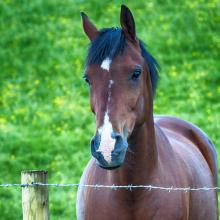Our horses wild ancestors evolved as ‘trickle feeders’. They grazed the Great Plains in their wild herds, eating constantly and resting intermittently, only galloping to escape the odd predator! Their stomachs are therefore designed to receive a constant supply of food, and so, unlike humans who produce stomach acid only when we eat, acid is released constantly into the stomach, like a tap permanently switched on!
This generally works well if the horse is eating most of the time because saliva, which is produced when they eat, neutralises this acid to digest the food. However, when the horse stops eating, or is not provided with food for long periods, the acid just keeps trickling into the stomach. But with no salvia to neutralise it, the acid in the stomach builds to high levels in the empty stomach.
If the horse is then exercised, especially at speed or jumping, the acid can be splashed up from where it sits in the lower part of the stomach (which has a protective skin lining) up to the top part of the stomach, which has a normal, vulnerable skin lining, creating lesions which become ulcerated.
Other factors associated with the formation of ulcers in the stomach and other parts of the digestive system, include are modern/domesticated stressors caused by travel, competitions, separation from peers and solitary confinement.
We will talk more about how you can help to prevent ulcers from forming in our next blog, but in the meantime, the key to managing your horse’s environment is to mimic nature as closely as is possible; constant foraging on grass or hay for as much of the day as you can, and try not to exercise your horse on an empty stomach - they are not like us! Feeding forage prior to exercise will actually help to reduce splashing the acid in to the upper part of the stomach.
If you think your horse may have stomach ulcers, contact your vet as soon as possible.
Next time we will discuss in more detail at how we can help prevent and treat gastric ulcers
